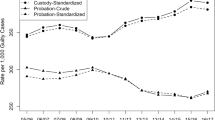Abstract
The English sentencing guidelines list multiple factors for judges to take into account at different steps to determine the appropriate sentence. Some of these factors aggravate the seriousness of the offence, whilst others mitigate its seriousness; additional factors are to be taken into account in personal mitigation. The idea that aggravating factors should increase the severity of the offender’s punishment and that mitigating factors do the opposite is straightforward. However, aside from the guilty plea discount (Sentencing Guidelines Council, 2007), there is no direction in the guidelines (and few attempts in the sentencing literature) to suggest how factors should be weighted or how they may interact (see Roberts, 2011).1 The only distinction in the guidelines is between factors taken into account at step one (when determining the offence category) and factors considered at step two, which serve to modify the assessment of overall seriousness within the range of the offence category. In the new format guidelines, judges are instructed as follows:2
The table below contains a non-exhaustive list of additional factual elements providing the context of the offence and factors relating to the offender. Identify whether any combination of these, or other relevant factors, should result in an upward or downward adjustment from the starting point. In some cases, having considered these factors, it may be appropriate to move outside the identified category range.
Access this chapter
Tax calculation will be finalised at checkout
Purchases are for personal use only
Preview
Unable to display preview. Download preview PDF.
Similar content being viewed by others
References
Adler, J. (1991) The Urgings of Conscience: A Theory of Punishment. Philadelphia: Temple University Press.
Ashworth, A. (2005) Sentencing and Criminal justice (4th edn). Cambridge: Cambridge University Press.
Bagaric, M., and Amarasekara, K. (2001) Feeling Sorry? — Tell Someone Who Cares: The Irrelevance of Remorse in Sentencing. The Howard Journal of Criminal Justice, 40(4): 364–376.
Bagaric, M. (2000) Double Punishment and Punishing Character: The Unfairness of Prior Convictions. Criminal Justice Ethics, 19(1): 10–28.
Davis, M. (1992) To Make the Punishment Fit the Crime: Essays in the Theory of Criminal Justice. Boulder, CO: Westview Press.
Duff, R.A. (1996) Penal Communications: Recent Work in the Philosophy of Punishment. Crime and Justice, 20: 1–97.
Lee, Y. (2009) Recidivism as Omission: A Relational Account. Texas Law Review, 87(3): 571–622.
MacPherson, D.L. (2002) The Relevance of Prior Record in the Criminal Law: A Response to the Theory of Professor von Hirsch. Queen’s Law Journal, 28: 177–219.
Maslen, H (forthcoming) Remorse, Penal Theory and Sentencing. Oxford; Hart Publishing.
Maslen, H., and Roberts, J.V. (2013) Remorse and sentencing: an analysis of sentencing guidelines and sentencing practice. In: A. Ashworth and J.V Roberts (eds) Sentencing Guidelines: Exploring the English Model. Oxford: Oxford University Press.
Murphy, J.G. (2006) Well Excuse Me — Remorse, Apology, and Criminal Sentencing. Arizona State Law Journal, 38: 371–386.
Roberts, J. V. (2008) Aggravating and Mitigating Factors at Sentencing: Towards Greater Consistency of Application. Criminal Law Review, (4): 264–276.
Roberts, J. V. (2008) Punishing Persistent Offenders: Exploring Community and Offender Perspectives. Oxford: Oxford University Press.
Roberts, J. V. (2010) Re-examining first offender discounts at sentencing. In: J.V. Roberts and A. von Hirsch (eds) The Role of Previous Convictions at Sentencing: Theoretical and Applied Perspectives. Oxford: Hart Publishing.
Roberts, J. V. (ed.) (2011) Mitigation and Aggravation at Sentencing. Cambridge: Cambridge University Press.
Roberts, J. V. and von Hirsch, A. (eds) (2010) Previous Convictions at Sentencing: Theoretical and Applied Perspectives. Oxford: Hart Publishing.
Sentencing Guidelines Council (2007) Reduction in Sentence for a Guilty Plea. Definitive Guideline. London: Sentencing Council of England and Wales.
Sentencing Council (2011) Assault. Definitive Guideline. London: Sentencing Council of England and Wales.
Sentencing Council (2013) Crown Court Sentencing Survey: Annual Publication, 2012. London: Sentencing Council of England and Wales.
Sundby, S. (1998) The Capital Jury and Absolution: The Intersection of Trial Strategy, Remorse, and the Death Penalty. Cornell Law Review, 83: 1557–1598.
Tamburrini, C. and Ryberg, J. (2012) Recidivist Punishments. The Philosopher’s View. New York: Lexington Books.
Tasioulas, J. (2006) Punishment and Repentance. Philosophy, 81(2): 279–322.
Tombs, J. and Jagger, E. (2006) Denying Responsibility: Sentencers’ Accounts of Their Decisions to Imprison. British Journal of Criminology, 46: 803–821.
Tudor, S.K. (2008) Why Should Remorse Be a Mitigating Factor in Sentencing? Criminal Law and Philosophy, 2(3): 241–257.
von Hirsch, A. and Ashworth, A. (2005) Proportionate Sentencing. Oxford: Oxford University Press.
Ward, B.H. (2006) Sentencing Without Remorse. Loyola. U. Chi. LJ, 38: 131–895.
Wasik, M. (1987) Guidance, guidelines and criminal record. In: M. Wasik and K. Pease(eds) Sentencing Reform: Guidance or Guidelines? Manchester: Manchester University Press.
Wasik, M. and von Hirsch, A. (1994) Section 29 Revised: Previous Convictions in Sentencing. Criminal Law Review, June: 409–418.
Editor information
Editors and Affiliations
Copyright information
© 2015 Hannah Maslen
About this chapter
Cite this chapter
Maslen, H. (2015). Penitence and Persistence: How Should Sentencing Factors Interact?. In: Roberts, J.V. (eds) Exploring Sentencing Practice in England and Wales. Palgrave Macmillan, London. https://doi.org/10.1057/9781137390400_10
Download citation
DOI: https://doi.org/10.1057/9781137390400_10
Publisher Name: Palgrave Macmillan, London
Print ISBN: 978-1-349-48259-7
Online ISBN: 978-1-137-39040-0
eBook Packages: Palgrave Social Sciences CollectionSocial Sciences (R0)




